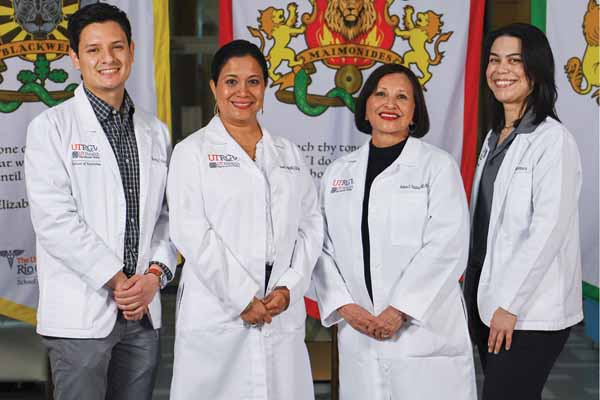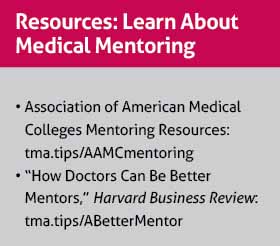
Like every physician, Harlingen family physician Adela Valdez, MD, understands that her career in medicine happened in part because of hard work – but also because a lot of people guided her way.
“I don’t know, to be quite honest, how I made it through from where I started to where I am. What I do know for sure is that mentoring has been a big factor in my success,” said Dr. Valdez, a member of the Texas Medical Association Council on Medical Education and associate dean for diversity, inclusion, and health equity at The University of Texas Rio Grande Valley (UTRGV) School of Medicine. “And obviously it was not mentoring by people who look like me. In fact, most of them were white males.”
Finding mentors is important for all aspiring physicians, and mentorship is considered an essential tool for addressing one of medicine’s biggest problems – the chronic lack of Black and Hispanic physicians. Texas’ physician workforce still does not resemble the state’s diverse population. (See “Diversity in Medicine,” page 26.)
Those disparities explain why TMA in 2021 approved policy that encourages Texas physicians to be mentors (tma.tips/TMAmentoring).
“Every physician, in every type of practice or practice setting, can have a valuable role in mentoring the next generation of physicians,” the policy states. “Students of underrepresented minorities often have a greater need for mentoring and support to counter challenges in pursuing the pathway to become a physician.”
Texas needs more physicians of color because many regions where Black and Hispanic people live in Texas remain underserved.
Also, numerous scientific studies show that people of color are wary of white physicians because of past racial injustices. For instance, Black men historically mistrust the U.S. medical system and have the lowest life expectancy of any demographic group in the country, according to a 2018 study published by the National Bureau of Economic Research (tma.tips/NBERStudy).
But those patients are more likely to select every preventive service prescribed once they meet a physician who is of the same race, the same study found.
Mentoring can improve diversity in other important ways, says Charles Mouton, MD, executive vice president, provost, and dean of The University of Texas Medical Branch School of Medicine in Galveston.
“When we’re talking about diversity, we’re not just talking about race and ethnicity,” he said. “Part of our problem with the physician workforce is the distribution of where physicians choose to set up their practice. Rural areas still remain underserved.”
Improving diversity can help all physicians gain a better understanding of their patients and coworkers, says M. Yvette Williams-Brown, MD, a gynecologic oncologist and associate professor of women’s health at The University of Texas at Austin Dell Medical School.
“Having more people around you who may have a different background, that look different than you – a different gender, a different upbringing – I think that opens the possibility that not everyone feels this way or thinks this way,” said Dr. Williams-Brown, who also mentors students.
Some of the best mentors for young people of color are Black and Hispanic physicians, Dr. Valdez says. But Texas does not have enough of them to advise the students who need mentoring.
More importantly, as her own
example shows, mentors don’t need to look or speak like the students they’re working with to guide them down the difficult path to a medical degree, she says.
“Most doctors have the ability to mentor students,” Dr. Valdez said. “Physicians want to leave a legacy, and part of that legacy is to help others come through that path they just went through.”

The leaky pipeline
Medical schools have “pipeline programs” designed to attract top students of color into their ranks. Each school works with its applicable accrediting body – either the Liaison Committee on Medical Education or the American Osteopathic Association Commission on Osteopathic College Accreditation – to set up diversity categories, Dr. Valdez says.
Each school adopts categories of students that it most wants to attract, she says.
“It’s not that the schools won’t take anybody [else],” she said. “It’s just that they select groups that best meet their mission.”
UTRGV School of Medicine focuses on recruiting students who have lived in the Rio Grande Valley – as well as students who are Black, Hispanic, and female – and tailors its pipeline programs accordingly, she says.
For instance, the Vaqueros MD Early Assurance Program focuses on recruiting a limited number of high-achieving South Texas students who do their undergraduate work at The University of Texas Rio Grande Valley. Accepted students can gain conditional admission to the university’s medical school – regardless of their major – if they have good academic achievement and do well on the Medical College Admission Test (MCAT).
But the pipeline to get students from elementary school to medical school is long and leaky.
Many students today who are Black and Hispanic are the first people in their families with a shot at going to college, let alone medical school, Dr. Valdez says. Without guidance from a physician, they can easily hurt their chances of getting into medical school. That can happen with something as basic as not having enough science or math in elementary school.
“They’re asking students earlier and earlier to make decisions about their life career that they just don’t have the knowledge to make,” she said.
Also, as kids grow, they naturally explore other career options, and many talk themselves out of medicine – often because they don’t think they’re good enough for medical school, Dr. Mouton says.
“They need to see the continued opportunity [of medical school] to keep moving down the path toward being a physician,” he said.
Standardized tests also pose an obstacle. Many students who are Black and Hispanic either can’t afford or don’t know the importance of prep classes for standardized tests like the Scholastic Aptitude Test (SAT) or the MCAT, Dr. Mouton says. As a result, they get lower scores and that makes their path to medical school even tougher.
Physicians can help students steer around these and other obstacles, and numerous organizations offer formal mentoring opportunities for doctors-to-be, Dr. Mouton says. Those organizations include county medical societies, civic clubs, and scouting organizations. Also, most academic medical centers have formal mentoring programs.
However, physicians can just call up a local school on their own and get started, says Laredo dermatologist Robert “Don” Hudson, MD, who serves on the TMA Committee on Physician Distribution and Health Care Access, which developed TMA’s new mentoring policy.
“Every career day [at local public schools], I’ll talk to the counselors and try to find someone with possible interest in medicine or science and have them come shadow me [for a day],” he said. “Hopefully, from that, if they show interest, I’ll say, ‘If you’d like, in the summertime you can come shadow me [some more.]’”
Some students need time to mature, and some lose interest in medicine quickly, he says. But all physicians interested in mentoring should be confident they have something valuable to teach young people.
“The high schoolers are overall very good – very respectful – and many of them are willing to learn,” he said. “And fortunately, some of [the ones I’ve mentored] have gone on to med school and done well.”
Different perspectives
As an African American infectious disease specialist living in El Paso, Ogechika Alozie, MD, has long served as a mentor to Black students at all academic levels. Students’ concerns vary according to their age level, he says.
In his experience, Black high school and college students typically worry most about advancing to the next academic level. But by the time they become residents or physicians, their conversations turn to problems like racism, classism, and bias they see among other physicians.
“Or [they talk about] patients treating them like the janitor even though they clearly have an MD badge on,” Dr. Alozie said.
His best advice in those situations is to adopt the philosophy of the March Madness college basketball tournament – survive and advance. Once medical students or residents become practicing physicians, they will be in a better position to address any racism they might face, he says.
Many white physicians serving as mentors might feel unqualified to offer advice in those types of situations, Dr. Valdez says. But an important aspect of mentorship is understanding when a student needs the perspective of another physician and being ready to help the student find it.
“It’s understanding when [the student] needs to have multiple mentors or when you need to move them along,” she said. She adds: “The goal is for the mentee to excel and move on to the next mentor.”
Increasing diversity in the physician workforce through improved mentorship is not a cure-all for the discrimination in medicine people of color regularly report, Dr. Williams-Brown says. Even if the number of physicians who are Black and Hispanic matched or even exceeded the percentage of those in the population, many of those patients would still rely on white physicians.
“Everyone needs to be aware of these issues [about racial and ethnic discrimination in medicine] and how we can ensure that we are thinking about how we’re treating all patients and evaluating our own personal biases and also evaluating systems biases and how …. people fall through the cracks,” she said. (See “Moving People Together,” page 16.)
Nevertheless, making Texas’ physician workforce more diverse is an important step in addressing those issues, and improved mentoring is vital for bringing Black and Hispanic students into medicine, Dr. Valdez says.
Also, physicians who are new to mentoring will be pleasantly surprised by how gratifying it is to help young people achieve a lifelong dream, she says.
“It gives back,” Dr. Valdez said. “It really gives back in a beautiful way. If you want to give of your time to mentoring, you’re going to receive a great deal more.”
Tex Med. 2022;118(5):32-36
May 2022 Texas Medicine Contents
Texas Medicine Main Page